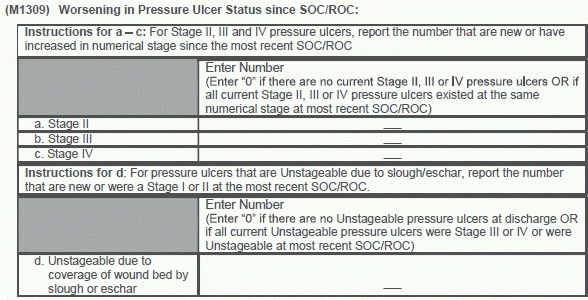Home Health Coding and OASIS Expert
Brush up on these Pressure Ulcer Basics
Take 3 steps for M1309 accuracy.
The OASIS pressure ulcer items have never been easy to answer, and they’re about to take on even more significance as they become the focus of new quality measures. Make certain you’re not setting yourself up for trouble down the line by fine-tuning your approach to M1309 — Worsening in Pressure Ulcer Status since SOC/ROC before it’s in the Centers for Medicare & Medicaid Services’ spotlight.
You’ll complete OASIS item M1309 at discharge. In each row, a-d, indicate the number of new or worsened Stage II, III, IV, or Unstageable pressure ulcers your patient has. Three steps can guide you to correct answers.
Step 1: Determine whether your patient has any pressure ulcers at each specified stage. If not, enter a “0” in the corresponding row.

Step 2: If your patient does currently have any Stage II, III, or IV pressure ulcers, you’ll need to review the history of each pressure ulcer. Look for documentation that indicates whether the pressure ulcers are new or if the patient had them at the time of the most recent SOC/ROC assessment.
If the patient has pressure ulcers that were present at the most recent SOC/ROC assessment, compare the current stage to the stage that was reported previously.
Count up the number of pressure ulcers at each stage that are new or that have increased in stage since the most recent SOC/ROC assessment. Report the numbers in the corresponding rows.
If your patient has no new or worsened pressure ulcers for a particular stage, enter “0” in that. For example, if the pressure ulcer was a Stage II at ROC and is still a Stage II at DC, you would answer “0” in row a.
Step 3: Determine whether the patient has any pressure ulcers that are currently Unstageable due to coverage of the wound bed by slough or eschar. “Pressure ulcers that are Unstageable due to slough or eschar are those in which the wound bed is not visible due to some degree of necrotic tissue or scabbing that the clinician believes may be obscuring the visualization of bone, muscle, tendon or joint capsule (Stage IV structures),” CMS says in the Response-Specific Instructions for M1309.
Exception: If you can see any Stage IV structures, you can’t count the pressure ulcer as Unstageable. In this situation, your patient has a Stage IV pressure ulcer, even if slough or eschar is present, CMS says.
If your patient has an Unstageable pressure ulcer, review the record to see whether the pressure ulcer existed at the most recent SOC/ROC assessment. If the Unstageable pressure ulcer didn’t exist or was previously a Stage I or II, report it in row d.
But if your patient has no Unstageable pressure ulcers at discharge, or if all current Unstageable pressure ulcers were III, IV, or Unstageable at the most recent SOC/ROC assessment, you’ll enter “0” in row d.
Tip: Suspected deep tissue injuries are not counted in M1309, regardless of whether they were present at SOC/ROC or discharge.
Home Health Coding and OASIS Expert
- ICD-10:
Follow these Tips to Smooth the Way with ICD-10
Stay on your toes with combination codes, seventh digits. By now, you’ve been coding in [...] - ICD-10 Transition:
ICD-10 Claims Processing Hits a Few Bumps in the Road
Adjustments are on the way. Understanding and using ICD-10 codes correctly isn’t the only hurdle [...] - Diagnosis Coding:
Get Answers to These Pressing ICD-10 Questions
The jury’s still out on ulcer severity selection. Now that you’re learning by doing with [...] - Include these Conditions Despite Excludes Notes
As ICD-10 codes begin to be put to practical use, some flaws with the shiny [...] - Quality Measures:
Prepare for New Pressure Ulcer Quality Measure
OASIS height and weight data collection poses a challenge. The Centers for Medicare & Medicaid [...] - OASIS:
Brush up on these Pressure Ulcer Basics
Take 3 steps for M1309 accuracy. The OASIS pressure ulcer items have never been easy [...]

